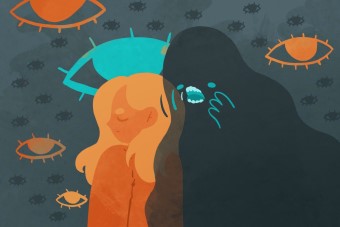Schizophrenia is a chronic mental illness that is characterized by the violation of thinking processes with relatively intact intelligence, which is combined with significant emotional impoverishment and decreased volition. It often coexists with hallucinatory and delusional disorders. For the first time, this term was used by the Swiss psychiatrist Eugen Bleuler in 1908. Obviously, schizophrenia existed before that but was acknowledged only in the XX century as a special case of psychosis.
Schizophrenia (from Ancient Greek σχίζω skhízō, “to split” + φρήν phrḗn “mind, heart, diaphragm”), earlier — dementia praecox (from Latin dēmentia praecox — “untimely madness” or “premature dementia”).
Early symptoms
- Internal anxiety and tension
- Irrational fear
- Insomnia
- Troubles with the attention span
- Trouble thinking clearly
- Irritability, distrust
- Loss of interest in life, despondency
- Shutting off the world
- Hypersensitivity to sounds and noise
- Problems in relationships with family and friends
In psychiatry, all schizophrenia symptoms are divided into positive (productive) and negative.
Positive symptoms:
- Delusions
- Hallucinations
- Depersonalization
- Derealization
Negative symptoms:
- Worsened thinking
- Decreased attention
- Poor speech
- Decreased social activity
- Loss of interest
Nowadays the main types of schizophrenia are:
Paranoid
Hebephrenic
Catatonic
Undifferentiated
Residual
Simple
Latent
Pseudoneurotic
Pseudopsychopatic
"Poor symptoms"
Cyclic
Paranoia
Starting from the beta version of ICD-11, following the American Psychiatric Association and DSM-5, all subtypes of schizophrenia were deleted.
The ICD-11 highlights:
schizophrenia, first episode;
schizophrenia, several episodes;
schizophrenia, continuous;
other specified episodes of schizophrenia;
schizophrenia, episode unspecified.
Meaning all of the subtypes (paranoid, catatonic, hebephrenic, etc) were eliminated, the diagnostic criteria were revised, the options of the course (first episode, multiple episodes), and the stages of endogenous psychosis (acute episode, partial remission, full remission). Instead of types, ICD-11 introduced the following symptoms: positive, negative, depressive, manic, psychomotor, and cognitive.
International Statistical Classification Of Diseases and Related Health Problems (ISCDRHP) is a document that serves as the leading statistical and classification framework in healthcare. It is reviewed every ten years under the guidance of the World Health Organization (WHO).
Paranoid schizophrenia
Paranoid schizophrenia — is the most popular type. The paranoid type of schizophrenia is characterized by: delusion of persecution, attitudes, meanings, and special purpose, body changes, jealousy or noble birth, voices speaking commands or threats, nonverbal auditory hallucinations, as well as taste, tactile, and/or olfactory hallucinations. Also characterized by emotional inadequacy, sudden mood swings, anger, or panic attacks.
Hebephrenic schizophrenia
Hebephrenic schizophrenia is characterized by: reasonableness, mannerism, unpredictable behavior, usually foolishness, and delusions. Causeless laughter, pranks, and repetitive verbal expressions are quite usual.
This exact type of schizophrenia is characterized by a disconnection between speech and thinking, which is a negative symptom.
Catatonic schizophrenia
The psychomotor disorder characterizes catatonic schizophrenia — from hyperkinesis to stupor. Numbness can last a long time, on the other hand, wavy flexibility is also observed. One of the main characteristics is periodically occurring anger episodes.
Simple schizophrenia is quite rare and is characterized by increasing negative symptoms, which causes a reduction in socialization opportunities and adequate reactions. No productive symptoms.
SCHIZOAFFECTIVE DISORDER
Schizoaffective disorder is an episodic disorder in which requirements for the diagnosis of schizophrenia and a manic, mixed, or depressive (moderate or severe) episode are fulfilled during the same period of the illness either simultaneously or with an interval of several days. In other words, it contains two interrelated components: mood pathology (depression or mania) and schizophrenic symptoms (delusions, hallucinations).
Symptoms of schizoaffective disorder might be similar to schizophrenia, bipolar disorder, and other mental disorders.
Significant symptoms of schizophrenia (delusions, hallucinations, disorganized thoughts, experiences of influence, possession, and control) come with typical symptoms of moderate or several depressive episodes (bad mood, loss of interest, low energy), manic episodes (overly expressive mood state: usually euphoria, irritability or expansiveness, higher activity or subjective feeling of higher energy), or a mixed episode.
In schizoaffective psychosis, symptoms are divided into three combined and alternating with each other groups:
- Psychotic symptoms — loss of connection with reality, hallucinations, delusions, disordered thinking.
- Manic symptoms — social disinhibition, overly high self-esteem, less need for rest and sleep, impulsiveness, and sudden anger outbursts.
- Depressive symptoms — loss of interest in life, tiredness, bad concentration, low self-esteem, suicidal thoughts, and loss of appetite.
In schizoaffective disorder, the symptoms depend on the type of disease:
1. manic type — hallucinations and delusions with unusually elevated mood, hyperactivity, and disinhibition;
2. depressive type — hallucinations and negative delusions with worsened mood, loss of interest in life, and the feeling of yearning;
3. mixed type — includes symptoms of both types switching each other.
SCHIZOTYPAL DISORDER
The schizotypal disorder is a mental disorder characterized by symptoms similar to schizophrenia (for example disordered thinking and emotions, eccentric behavior, coldness, paranoid ideas but not on a delusional level, social isolation, etc), however, it is periodic and not so vivid.
Symptoms:
- Paranoia or excessive suspicion
- Disinterest, detachment, coldness
- Struggling to establish contact with people
- Inadequacy, eccentric behavior
- Obsessive ideas
- Hallucinations
- Depersonalization
- Disorientation
The idea of “schizotypal disorder” has gradually evolved: latent schizophrenia; “light” schizophrenia; non-psychotic schizophrenia; sanatory schizophrenia; occult schizophrenia; pseudo-neurotic schizophrenia; slow schizophrenia; larvated schizophrenia; sluggish schizophrenia; failed schizophrenia; prodromal schizophrenia; non-progressive schizophrenia; schizotypal disorder.
